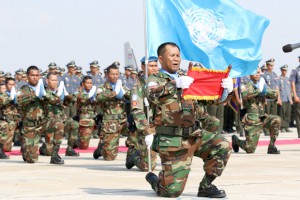Last month’s attack by jihadi gunmen in the Ivoirian beach town of Grand Bassam did not come as a complete surprise to West Africa observers. In recent months, al-Qaeda in the Islamic Maghreb (AQIM) — which claimed responsibility for the Grand Bassam assault — and its al-Mourabitoun affiliate have shifted their lethal focus to hotels frequented by tourists and Western expatriates. Ostensibly in retaliation against African support of France’s ongoing efforts to counter jihadi groups in the Sahara-Sahel region, this change in targeting patterns already led to last November’s Radisson Blu siege in Bamako and the deadly attack at Ouagadougou’s Splendid Hotel and Cappuccino Cafe on January 15.
Still, the killings in Grand Bassam represent a troubling development. By striking a target approximately 1,400 kilometers removed from its traditional area of activity, AQIM demonstrated its reach. It is also significant that the incident took place near Côte d’Ivoire’s commercial capital, Abidjan. Previously, the economic hubs along West Africa’s coast appear to have been spared from the violence that AQIM has afflicted in parts of the Sahel. Some security analysts believe AQIM will likely attempt to follow up the Grand Bassam massacre with additional attacks in Côte d’Ivoire, as well as Senegal. A leaked security memo from the Ghana Immigration Service indicates that Accra officials consider the Ghanaian state and neighboring Togo to be also at risk of being violently targeted by AQIM.
Countering the AQIM threat to littoral West Africa will prove challenging. As a major destination for investment and home to the headquarters or regional offices of several prominent international organizations, the area is rich with targets. Migration patterns tied to the region’s economy, meanwhile, make it relatively easy for members of outside groups to infiltrate local communities. Those opposed to AQIM and its fellow travelers would do well to continue emphasizing improvements in surveillance and intelligence sharing among West African countries, rather than embrace heavy-handed tactics. Affected states should also pursue reforms aimed at enhancing governance to inoculate their societies from Islamic extremism.
Despite its Maghrebi origins, AQIM has exhibited an ability to broaden its recruitment base in the Sahel. Operatives often modify their group’s messaging to appeal to individuals from various ethnicities, demonstrating a remarkable degree of knowledge of local issues and cultural dynamics. Some jihadis have even allegedly married into indigenous clans for the purpose of winning their support for AQIM.
The 2015 reconciliation between AQIM and al-Mourabitoun seems to have further diversified the former’s membership. The latter had previously been an AQIM splinter group reputedly responsible for a number of small-scale attacks on U.N. and civilian targets in the Sahel. Al-Mourabitoun brought along with it remnants of the Movement for Oneness and Jihad in West Africa, a jihadi faction that had made some inroads among ethnic Songhai and Fulani populations of northern Mali. Indeed, available information indicates that in the cases of the Bamako, Ouagadougou, and Grand Bassam attacks, the jihadi terrorists included Fulani gunmen. Several Malian nationals have been detained since Grand Bassam for allegedly assisting the assailants. The suspects include at least three individuals based in the Abidjan metropolitan area, where they reputedly conspired with an Ivoirian whom authorities have since arrested.
This reported participation of native West Africans in AQIM operations must be troubling for the governments of Côte d’Ivoire, Ghana, and Senegal. All three countries attract large numbers of economic migrants from the Sahel, particularly Malians and Burkinabe. Predominantly young men, these migrants travel to littoral West Africa to work as laborers on commercial farms or as petty traders. Abidjan and Accra possess teeming neighborhoods of foreign-born migrants, many of whom spend seven to eight months a year in these urban areas before returning to their home villages in time for the annual harvest.
Such population movements lead to high turnover among the migrant community, which in turn makes it difficult for authorities to monitor the comings and goings of outsiders. Little information is publicly available on the itinerary allegedly used by accused AQIM conspirator Alou Doumbia to transport the Grand Bassam attackers into Côte d’Ivoire. It is possible, however, that the jihadis exploited existing migration routes to avoid detection. Even if this does not turn out to be the case, the transient nature of large segments of West Africa’s migrant population poses a challenge to attempts to identify AQIM cells. Closing the region’s international borders is not economically or logistically feasible and — particularly in the case of Côte d’Ivoire — would threaten to exacerbate social tensions.
The rise of Islamic fundamentalism in littoral West Africa represents another potential obstacle to countering violent extremism. There is scant evidence to suggest that any of the revivalist movements that have gained prominence in the region actively harbor jihadi sympathizers. Nevertheless, their growth has chipped away at the influence of the religious establishments that have often served as the primary interlocutors between the national governments and local Muslim communities. This growing disconnect increases the likelihood of officials being unaware of radical Islamist activities within their jurisdictions.
Successfully addressing these challenges will require augmenting the intelligence-gathering capabilities of local security forces.. The region’s governments need to devote additional attention and resources to developing informant networks and adopting community-policing practices. In addition, steps should also be taken to cultivate stronger relations with peaceful Islamic fundamentalists, an endeavor that would require discretion and a high degree of political finesse. West African states would need to ensure their outreach efforts do not upset other religious constituencies (e.g. Christians, Sufi Muslims) and are sensitive to mainstream Islamists’ concerns of being perceived as government collaborators.
Countries affected by the AQIM menace should also build upon existing intelligence-sharing arrangements among themselves. This objective should be achievable, as all the major state actors in the region now recognize the threat that AQIM represents. What’s more, the foundations already exist in the form of the Nouakchott Process and Sahel G5. Since the Grand Bassam attack, West African officials have reportedly met to explore ways to bolster regional cooperation. These are promising steps that, if followed through, would help further reduce information gaps on AQIM, allowing authorities to disrupt attacks in their preparation stages.
Conversely, the use of security tactics, such as mass detentions and large-scale neighborhood sweeps, would probably backfire. Besides squandering precious resources, this approach would anger local Muslim fundamentalists, driving some into the arms of AQIM. Government officials should treat the current threat as a law enforcement challenge, and resist the temptation to militarize their respective counterterrorism responses.
Of course, better intelligence alone will not completely shield the states of littoral West Africa from violent Islamic extremism. Even if it becomes markedly more difficult for AQIM to infiltrate the region, there still exists the danger of homegrown terrorist cells emerging. Aspiring jihadis could draw inspiration from al-Qaeda’s toxic ideology to craft their own extremist narratives. Youth disillusionment with the sociopolitical status quo has created a pool of alienated individuals susceptible to the manipulations of craven killers who wrap themselves in robes of leadership and piety.
Any successful counterterrorism strategy, therefore, must also consider reforms designed to improve local governance and economic opportunity for the region’s youth. Corruption remains rampant, while access to various social services in both rural areas and the region’s burgeoning urban centers is woefully inadequate. More importantly, youth unemployment may be the single greatest challenge facing the region. The level of youth unemployment, if not addressed, will serve as fodder for jihadi groups trolling for disillusioned young people lacking economic and social alternatives to their violent ideologies. To ensure that communities are allergic to violent extremism, these issues need to be attended to in a more robust manner.
The threat of terrorism and the likelihood that further attacks will occur is fast becoming the new normal for littoral West Africa. Confronting this reality in a successful and sustainable fashion will require local political leaders to pursue coordinated, intelligence-driven strategies against AQIM, while concurrently investing additional resources towards strengthening governance and economic growth. Failure to do so could condemn the region to an extended era of jihadi violence.
warontherocks.com












